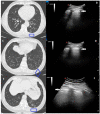Low Sensitivity of Admission Lung US Compared to Chest CT for Diagnosis of Lung Involvement in a Cohort of 82 Patients with COVID-19 Pneumonia
- PMID: 33806432
- PMCID: PMC8001137
- DOI: 10.3390/medicina57030236
Low Sensitivity of Admission Lung US Compared to Chest CT for Diagnosis of Lung Involvement in a Cohort of 82 Patients with COVID-19 Pneumonia
Abstract
Background and Objectives: The potential role of lung ultrasound (LUS) in characterizing lung involvement in Coronavirus disease 2019 (COVID-19) is still debated. The aim of the study was to estimate sensitivity of admission LUS for the detection of SARS-CoV-2 lung involvement using Chest-CT (Computed Tomography) as reference standard in order to assess LUS usefulness in ruling out COVID-19 pneumonia in the Emergency Department (ED). Methods: Eighty-two patients with confirmed COVID-19 and signs of lung involvement on Chest-CT were consecutively admitted to our hospital and recruited in the study. Chest-CT and LUS examination were concurrently performed within the first 6-12h from admission. Sensitivity of LUS was calculated using CT findings as a reference standard. Results: Global LUS sensitivity in detecting COVID-19 pulmonary lesions was 52%. LUS sensitivity ranged from 8% in case of focal and sporadic ground-glass opacities (mild disease), to 52% for a crazy-paving pattern (moderate disease) and up to 100% in case of extensive subpleural consolidations (severe disease), although LUS was not always able to detect all the consolidations assessed at Chest-CT. LUS sensitivity was higher in detecting a typical Chest-CT pattern (60%) and abnormalities showing a middle-lower zone predominance (79%). Conclusions: As admission LUS may result falsely negative in most cases, it should not be considered as a reliable imaging tool in ruling out COVID-19 pneumonia in patients presenting in ED. It may at least represent an expanded clinical evaluation that needs integration with other diagnostic tests (e.g., nasopharyngeal swab, Chest-CT).
Keywords: COVID-19; Chest-CT; SARS-CoV-2 pneumonia; interstitial pneumonia; lung ultrasound (LUS); sensitivity.
Conflict of interest statement
The authors declare no conflict of interest.
Figures


Similar articles
-
Lung Ultrasound in COVID-19 Pneumonia: Correlations with Chest CT on Hospital admission.Respiration. 2020;99(7):617-624. doi: 10.1159/000509223. Epub 2020 Jun 22. Respiration. 2020. PMID: 32570265 Free PMC article.
-
Correlation between Chest Computed Tomography and Lung Ultrasonography in Patients with Coronavirus Disease 2019 (COVID-19).Ultrasound Med Biol. 2020 Nov;46(11):2918-2926. doi: 10.1016/j.ultrasmedbio.2020.07.003. Epub 2020 Jul 13. Ultrasound Med Biol. 2020. PMID: 32771222 Free PMC article.
-
Comparison of admission chest computed tomography and lung ultrasound performance for diagnosis of COVID-19 pneumonia in populations with different disease prevalence.Eur J Radiol. 2020 Dec;133:109344. doi: 10.1016/j.ejrad.2020.109344. Epub 2020 Oct 8. Eur J Radiol. 2020. PMID: 33091835 Free PMC article.
-
Thoracic imaging tests for the diagnosis of COVID-19.Cochrane Database Syst Rev. 2020 Nov 26;11:CD013639. doi: 10.1002/14651858.CD013639.pub3. Cochrane Database Syst Rev. 2020. Update in: Cochrane Database Syst Rev. 2021 Mar 16;3:CD013639. doi: 10.1002/14651858.CD013639.pub4. PMID: 33242342 Updated.
-
Lung Ultrasound May Support Diagnosis and Monitoring of COVID-19 Pneumonia.Ultrasound Med Biol. 2020 Nov;46(11):2908-2917. doi: 10.1016/j.ultrasmedbio.2020.07.018. Epub 2020 Jul 20. Ultrasound Med Biol. 2020. PMID: 32807570 Free PMC article. Review.
Cited by
-
Gastrointestinal microbiota: A predictor of COVID-19 severity?World J Gastroenterol. 2022 Dec 7;28(45):6328-6344. doi: 10.3748/wjg.v28.i45.6328. World J Gastroenterol. 2022. PMID: 36533107 Free PMC article. Review.
-
From the Triage to the Intermediate Area: A Simple and Fast Model for COVID-19 in the Emergency Department.Int J Environ Res Public Health. 2022 Jun 30;19(13):8070. doi: 10.3390/ijerph19138070. Int J Environ Res Public Health. 2022. PMID: 35805727 Free PMC article.
-
Point-of-Care Lung Ultrasound in the Intensive Care Unit-The Dark Side of Radiology: Where Do We Stand?J Pers Med. 2023 Oct 26;13(11):1541. doi: 10.3390/jpm13111541. J Pers Med. 2023. PMID: 38003856 Free PMC article. Review.
-
Lung ultrasound as a screening tool for SARS-CoV-2 infection in surgical patients.J Clin Ultrasound. 2022 Nov;50(9):1271-1278. doi: 10.1002/jcu.23358. Epub 2022 Oct 6. J Clin Ultrasound. 2022. PMID: 36200639 Free PMC article.
-
Review of COVID-19 testing and diagnostic methods.Talanta. 2022 Jul 1;244:123409. doi: 10.1016/j.talanta.2022.123409. Epub 2022 Mar 31. Talanta. 2022. PMID: 35390680 Free PMC article. Review.
References
-
- WHO Pneumonia of Unknown Cause–China. [(accessed on 30 May 2020)];2020 Available online: https://www.who.int/csr/don/05-january-2020-pneumonia-of-unkown-cause-ch...
-
- WHO Announces-COVID-19 Outbreak a Pandemic. [(accessed on 30 May 2020)];2020 Available online: https://www.euro.who.int/en/health-topics/health-emergencies/coronavirus....
MeSH terms
LinkOut - more resources
Full Text Sources
Other Literature Sources
Medical
Research Materials
Miscellaneous

